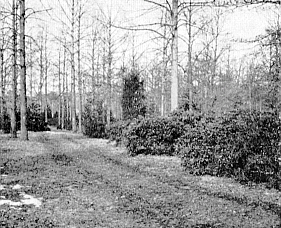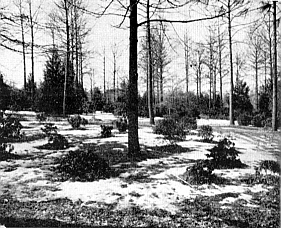The Rhododendron and Azalea Collection of the
John J. Tyler Arboretum
LIMA, DELAWARE COUNTY, PENNSYLVANIA
John C. Wister, Former Director (1946-1968)
Robert M. MacDonald, Director & Charles Finegan, Superintendent

|

|
|
Fig. 55. Part of the rhododendron collection at the John J. Tyler Arboretum. Taken on
a winter's day with temperatures at 8 degrees F. photos by Robert D. McDonald, Director |
|
The collection of Rhododendrons and Azaleas of the Tyler Arboretum includes over four thousand plants in over five hundred species and varieties (cultivars) and covers approximately six acres.
The first part of the collection was planted along wide trails in the old Oak, Hickory and Tulip forest directly north of the Arboretum buildings. Here, between 1951 and 1958, masses of
Rhododendron maximum
and of native Azaleas were used as backgrounds for over fifty different, and then little known, clones of selected and numbered Dexter hybrids.
The spectacular bloom in this area became so popular with our visitors that in 1960 plans were made for a new and much larger collection. The site chosen was several hundred yards to the east, in thick young woodland of Tulip and Ash on the border of the Pinetum.
Here, between rough wide trails opened by bulldozer, over forty sections (or "islands") were staked out. Some of the best trees were saved, and the poorer ones cut. In their places new trees of other species, mostly Pine, Hemlock, Oak, Dogwood and Holly were added and the ground prepared. About half the sections were planted in 1961 and 1962, and many additional sections in 1966 and 1967. Some sections are still left for future expansion.
The main purpose, from the beginning, was to present a semi-wild naturalistic garden in which the plants were grouped and classified by size, season of bloom and color and, equally important, by botanical relationship and by horticultural history.
The collection now (1971) includes roughly:
- 25 species of Rhododendron and 35 of Azaleas
- 150 cultivars (named varieties) of Rhododendron and 100 of Azaleas 150 cultivars (numbered clones) of selected Dexter hybrids
- 150 cultivars (numbered clones) of Swarthmore College hybrids selected from over 1000 plants of over 100 different crosses.
Here are comments on the different groupings to be seen when walking along the trails:
On entering beyond the pond and going up the hill, we come first to the Azaleas, which usually begin to bloom by May first and continue into late July. The earliest, in the first small section, are the species.>
R. vaseyi
(and its color forms and
schlippenbachii
. A little later there are wild hybrids between
nudiflorum
and
canescens
from Tennessee. Then there are numbered selections of the fate C. D. Beadle of Biltmore, North Carolina, of the species
atlanticum, canescens, arborescens, bakeri, prunifolium
, and
serrulatum
.
A larger section at the top of the hill features Dr. Henry T. Skinner's numbered selections of the species
alabamense, austrinum, canescens, serrulatum
and
viscosum
. Behind these are such named Ghents, Knap Hills and Exburys, as 'Daviesi', 'Brazil', 'Harvest Moon', and 'Sylphides', and some brilliant yellow Ilam seedlings.
To the east and north, several sections are devoted to over sixty Glenn Dale varieties. The fine introductions of Gable such as 'Springtime' (our earliest
kaempferi
hybrid), 'Rose Greeley', and 'Stewartstonian' are planted in the big section which features his Rhododendrons. A good many other Azaleas are scattered through many Rhododendron sections or massed along the borders of the Pinetum.
Now on to Rhododendrons and to the sections that seem to be particularly important or outstanding:
About fifty plants of over twenty species are concentrated in one section. They give a long season of bloom, from
mucronulatum
in early April to
maximum leachi
and
minus
in late July. Some that have grown particularly well here are
adenopodum, brachycarpum, keiskei, racemosum
and
vernicosum
.
When the better known horticultural varieties (cultivars) are to be used in gardens, the so-called "Iron-clads" (which are over a century old), should be the backbone of any collection on the east coast (north of Washington at least). We have about a hundred plants in thirty varieties in our most exposed areas. Among those we like best are 'Album Elegans', 'Boule de Neige', 'Chionoides', 'Delicatissimum', 'Mrs. C. S. Sargent', 'Nova Zembla', and Roseum Superbum'.
In an adjoining section, more sheltered from the wind, we have another thirty varieties that we consider hardy, but not quite as hardy. Among these are 'America', 'Bagshot Ruby', 'Duke of York', 'Michael Waterer', 'Mme. de Bruin', 'Mrs. P. den Ouden', 'Old Port', and 'Sefton'.
Nearby, one of the largest and most prominent sections, is given over to the breeding triumphs of Pennsylvania's own Joseph B. Gable. Among the over twenty named varieties are 'Atroflo', 'County of York', 'David Gable', 'Henry Yates', 'Mary Belle' and 'Strawberry Swirl'. There are also another twenty crosses, perhaps equally fine, that have not as yet been named.
Another prominent modern American breeder who is allotted a special section is Guy Nearing, who started in nearby Delaware and then moved to New Jersey. From him, we have almost twenty varieties. Among these are the Guyencourt set - 'Chesapeake', 'Delaware', 'Hockessin', 'Montchanin', etc.; the
carolinianum
hybrids, 'Windbeam', and 'Wyanokie', the very small 'Mary Fleming', and the large 'Gretchen' and 'Rochelle'.
We have smaller numbers of new seedlings from other American breeders - Edmond Amateis, Warren Baldsiefen, Paul Bosley, David Leach, Howard Phipps, Tony Shammarello and Paul Vossberg. Among their varieties are: 'Dora Amateis', 'Anna Baldsiefen', 'Boule de Rose' and 'Janet Blair', 'Brookville' and 'Wheatley', 'Belle Heller', 'Holden', 'Pinnacle' and 'Spring Fantasy' and 'Meadowbrook'.
In numbers, and perhaps in importance, the greatest strength of the Tyler collection is in the productions of the late Charles O. Dexter. We have devoted one section to fifty plants of fifteen named varieties, among them, 'Halesite', 'Huntington', 'Josephine Everitt', 'Scintillation', 'Todmorden', and 'Westbury'.
While these are acknowledged as among Mr. Dexter's best, it does not follow that those still under number, are not equally good. Scattered in half a dozen different sections, we have clones from fifteen different gardens to which Mr. Dexter had sent plants in the 1930s.
First of all, there are twenty of Mr. Dexter's own numbering; there are six selections from Paul Bosley; sixteen from Mrs. Henry Ross; five from Mr. Willard; and nearly fifty from the Scott Foundation of Swarthmore College.
Then we have about eighty numbered clones, which were selected for further trial in 1949, 1950, and 1951, by a committee of American Rhododendron Society members formed by Dr. Clement G. Bowers.
This committee started its visits each year at the New York Botanical Garden. On Long Island, it visited the Everitt, Parker and Phipps Estates, then went north to the Dexter Estate at Sandwich, then to the Arnold Arboretum and to B. P. P. Moseley in Ipswich and to H. W. Fowle and Mrs. F. M. Moseley in Newburyport.
Finally, there is a small group of Dexter hybrids, which the Scott Foundation had received from the Dexter Estate in 1945, and which Dr. Bowers' committee did not find anywhere in its travels. These are hybrids listed as
arboreum x maximum x decorum
, They are very tall growing plants, with magnificent foliage and very late flowers, blooming here in late June.
Nearly two thousand seedlings from the 1953, 1957 and 1958 breeding programs of the Scott Foundation have been grown in the nursery at the far end of the collection. Since 1965, these have been judged as they bloomed and each year the best have been numbered and put into more permanent positions for further judging as they mature. We believe that fifty or more of these will prove to be valuable additions to our massed woodland planting, as they bloom well in shaded positions and give flowers in late June, where nearly all other Rhododendrons except
maximum
and
minus
are over. Only the years can tell if any of these will be worth naming and introducing, but meantime, we and our visitors will have the pleasure and interest of watching them.
The Arboretum is open daily, without charge. We particularity invite Rhododendron growers to come to sep our plants and their flowers.